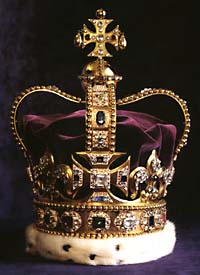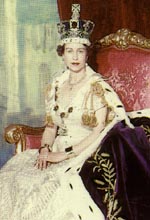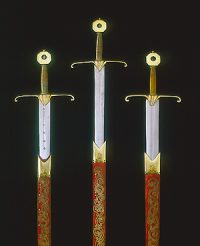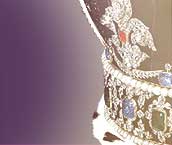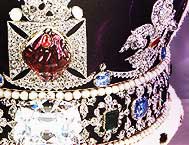|
HRH QUEEN ELIZABETH II
|
|
HOME | CASE STUDIES | HISTORY | LAW | POLITICS | RIGHTS | SITE INDEX | WHISTLEBLOWING |
|
THE MONARCHY RESTORED
St Edward's Crown, 1661
For over 600 years kings and queens of England have stored crowns, robes and other valuable items of ceremonial regalia at the Tower of London. Since the 17th century, at least, this collection has been known as the 'Crown Jewels' and has been shown to visitors to the Tower.
HM QUEEN ELIZABETH II
The Queen was born in London on 21 April 1926, the first child of The Duke and Duchess of York, subsequently King George VI and Queen Elizabeth. Five weeks later she was christened Elizabeth Alexandra Mary in the chapel at Buckingham Palace.
The Princess's early years were spent at 145 Piccadilly, the London house taken by her parents shortly after her birth; at White Lodge in Richmond Park; and at the country homes of her grandparents, King George V and Queen Mary, and the Earl and Countess of Strathmore. When she was six years old, her parents took over Royal Lodge in Windsor Great Park as their own country home.
Princess Elizabeth was educated at home with Princess Margaret, her younger sister. After her father succeeded to the throne in 1936 and she became heir presumptive, she started to study constitutional history and law. She also studied art and music; learned to ride (she has been a keen horsewoman since early childhood); and enjoyed amateur theatricals and swimming - she won the Children's Challenge Shield at London's Bath Club when she was thirteen. She enrolled as a Girl Guide when she was eleven, and later became a Sea Ranger.
As the Princess grew older she began to take part in public life. She broadcast for the first time in October 1940, when she was 14; she sent a message during the BBC's children's programme to all the children of Britain and the Commonwealth, particularly to those children who were being evacuated for safety reasons. In early1942 she was appointed Colonel-in-Chief of the Grenadier Guards, and on her sixteenth birthday she carried out her first public engagement, when she inspected the regiment. In April 1943, Princess Elizabeth carried out her first solo public engagement, when she spent a day with a Grenadier Guards tank battalion in Southern Command.
St Edward's Crown, 1661
Thereafter
her official duties increased, particularly in connection with young
people: she was President of the Queen Elizabeth Hospital for Children in
Hackney and the National Society for the Prevention of Cruelty to
Children. From March 1944 onwards, she also began to accompany the King
and Queen on many of their tours within Britain.
In early 1945 the Princess was made a Subaltern in the Auxiliary Territorial Service (ATS). By the end of the war she had reached the rank of Junior Commander, having completed her course at No. 1 Mechanical training Centre of ATS and passed out as a fully qualified driver.
After the end of the war, Princess Elizabeth's public engagements continued to grow, and she travelled extensively to attend public functions throughout the British Isles. These included the launching of a new aircraft carrier in Belfast and a tour of Ulster in March 1946, and attending the National Eisteddfod of Wales in August 1946.
Her first official overseas visit took place in 1947, when she accompanied her parents and sister on a tour of South Africa. During this tour she celebrated her twenty-first birthday, and gave a broadcast address dedicating herself to the service of the Commonwealth - a dedication she repeated five years later on her accession to the throne.
On her return from the South Africa tour, Princess Elizabeth received the freedom of the City of London in June 1947; in July, she received the freedom of the city of Edinburgh. In November 1947, Princess Elizabeth was created a Lady of the Garter at a private investiture by the King.
MARRIAGE
AND FAMILY The
Royal couple had four children, and seven grandchildren.
Their grandchildren are Peter and Zara Phillips (b. 1977 and 1981); Prince William of Wales and Prince Henry of Wales (b. 1982 and 1984); Princess Beatrice of York and Princess Eugenie of York (b. 1988 and 1990); and The Lady Louise Windsor, daughter of The Earl and Countess of Wessex (b. 2003).
HM Queen Elizabeth II coronation day 2 June 1953.
ACCESSION
AND CORONATION Her Majesty's coronation took place in Westminster Abbey on 2 June 1953.
Representatives of the peers, the Commons and all the great public interests in Britain, the Prime Ministers and leading citizens of the other Commonwealth countries, and representatives of foreign states were present. The ceremony was broadcast on radio around the world and, at The Queen's request, on television. It was television, then in its relative infancy, that brought home the splendour and the deep significance of the coronation to many hundreds of thousands of people in a way never before possible. The coronation was followed by drives through every part of London, a review of the fleet at Spithead, and visits to Scotland, Northern Ireland and Wales.
In 1660-1, the regalia was entirely remade for King Charles II and it is these objects, among them the crown, orb and sceptres with which Queen Elizabeth II was invested at her coronation, which form the heart of the collection in the Tower of London today.
The Coronation Regalia
ROLE
AS MONARCH
Since her Coronation, The Queen has also visited nearly every county in Britain, seeing new developments and achievements in industry, agriculture, education, the arts, medicine and sport and many other aspects of national life.
As Head of State, The Queen maintains close contact with the Prime Minister, with whom she has a weekly audience when she is in London, and with other Ministers of the Crown. She sees all Cabinet papers and the records of Cabinet and Cabinet Committee meetings. She receives important Foreign Office telegrams and a daily summary of events in Parliament.
Her Majesty acts as host to the Heads of State of Commonwealth and other countries when they visit Britain, and receives other notable visitors from overseas. She holds Investitures in Britain and during her visits to other Commonwealth countries, at which she presents honours to people who have distinguished themselves in public life.
As Sovereign, Her Majesty is head of the Navy, Army and Air Force of Britain. On becoming Queen she succeeded her father as Colonel-in-Chief of all the Guards Regiments and the Corps of Royal Engineers and as Captain-General of the Royal Regiment of Artillery and the Honourable Artillery Company. At her Coronation she assumed similar positions with a number of other units in Britain and elsewhere in the Commonwealth. (A full list appears in Whitaker's Almanack.)
Every year, Her Majesty entertains some 48,000 people from all sections of the community (including visitors from overseas) at Royal Garden Parties and other occasions. At least three garden parties take place at Buckingham Palace and a fourth at the Palace of Holyroodhouse, in Edinburgh. Additional 'special' parties are occasionally arranged, for example to mark a significant anniversary for a charity. In 1997, there was a special Royal Garden Party attended by those sharing The Queen and The Duke of Edinburgh's golden wedding anniversary. In the summer of 2002 there was a special Golden Jubilee Garden Party for individuals born on Accession Day, 6 February 1952.
Her Majesty also gives regular receptions and lunches for people who have made a contribution in different areas of national and international life. She also appears on many public occasions such as the services of the Orders of the Garter and the Thistle; Trooping the Colour; the Remembrance Day ceremony; and national services at St Paul's Cathedral and Westminster Abbey. The Queen is Patron or President of over 700 organisations. Each year, she undertakes a large number of engagements: some 478 in the UK and overseas in 2003.
Further information about the Crown Jewels can be found in the Official Crown Jewels Guidebook.
NEWS HOW DO I ? CHILDREN MAGAZINE FAQS LINKS SITE MAP VISITORS BOOK
THE SIX WIVES OF HENRY VIII
WE ACCEPT NO RESPONSIBILITY FOR THE ACCURACY OF ANY FEATURED LINKS
|
|
IF YOU HAVE ANY GOOD STORIES TO TELL WE'D LIKE TO HEAR FROM YOU. WHY NOT BUILD A WEBSITE OF YOUR OWN TO TELL OF PROBLEMS IN YOUR AREA - IT'S YOUR RIGHT. WE WILL LINK TO YOUR SITE WITH A SHORT SUMMARY.
With thanks to Action Groups around the world for the supply of real case history and supporting documents.
|
